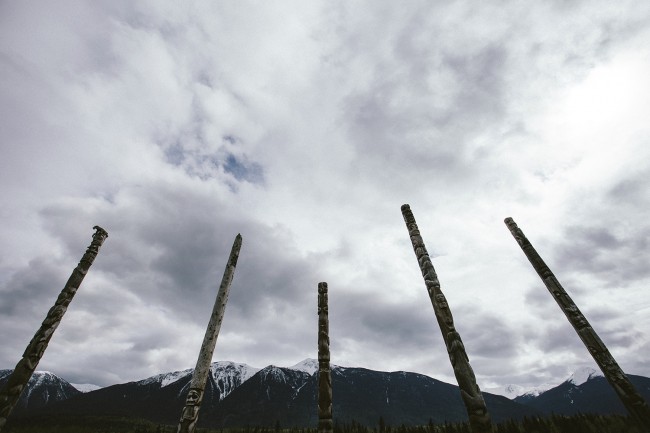
Photo Credit: Marty Clemens
Reconciliation
Reconciliation. The word has been in Canadian lexicon for a few years now, but what does it really mean? What does reconciliation look like in our communities, and how can we all benefit by choosing to reconcile?
Formally, reconciliation means reuniting, reunion, harmonization, and restoration of friendly relations. But its definition in the wake of Canada’s residential school system is a slippery one, with as many meanings as there are individuals trying to reconcile their lives.
For many non-Indigenous people—myself included—reconciliation isn’t an action that has been fully embraced. Not due to lack of sympathy or empathy for those who experienced residential schools, or the subsequent generations who continue to struggle with effects of horrific acts by individuals and governments that embraced the residential school system. No, at first blush, inaction appears to be a result of the impression that the potential benefits of reconciliation won’t positively impact our lives, so there’s no spark of desire to start. As with many activities that jostle for priority in overly busy lives, to receive the commitment of that commodity called time, reconciliation needs to do some good. Not just for Indigenous people, but for non-Indigenous people, too. Some—and I include myself in this—are simply not altruistic enough to do the hard work of reconciliation if there’s no obvious personal benefit.
At a deeper level, this lack of action may be less about apathy and more about a fear of opening a Pandora’s box of shame. Acknowledging the ugly darkness of our country’s history means shattering the idea of inherent Canadian values of justice and equality. And then, it will be ignoble not to act.
After six years of hearings and testimony, Canada’s Truth and Reconciliation Commission put forward 94 recommendations to address the cultural genocide of Aboriginal peoples through Canada's residential school system. So perhaps it’s not surprising that when faced with reconciliation as a conversation piece, many feel unsettled. In 2015, Phil Fontaine, the former National Chief of the Assembly of First Nations said, “One thing that’s pretty obvious, is that Canada was not the country that we thought it was. But it certainly has an opportunity now—a real opportunity—to create the Canada that we all want to see.” For those whose knowledge of First Nations history comes from decades-old grade-school learning that embraced a cleansed version of history, the Kool-Aid may suddenly seem like blood-tainted water. Repugnant as it is, becoming cognizant of this duplicity in historical teaching is an important first step.
Understanding the issues of a conversation that’s writ so large across our communities isn’t easy. Former National Chief of the Assembly of First Nations Shawn A-in-chut Atleo describes residential school history as a long dark shadow across the country, where light needs to be shone. He also provides guidance. “You are a treaty person, irrespective of where you reside or whether you are of Indigenous heritage. You have also inherited this legacy, this history, and you can also play a part in reconciliation. Education is about learning. Learning promotes and supports healing. Healing relationships in and between Indigenous people, and between Indigenous people and the state, and Indigenous people and Canadians—that’s the work of reconciliation.”
What does reconciliation work really look like? Lisa Raven, Executive Director of Returning to Spirit, a non-profit organization that delivers reconciliation workshops across the country, shared her own journey. Raven is Indigenous and grew up in Manitoba, experiencing racism and abuse. “After a while, the blame doesn’t just stay with the Church and residential school,” she says. “Everybody gets painted with that brush.”
She describes her own deep biases—assumptions towards herself and non-Indigenous people. “I started to really harden against people who weren’t like me. A lot of it was based on trying to protect myself from being hurt. There was resentment that I wasn’t aware of. I had some big chips on my shoulders. Lots of anger and hurt. Hurt compounded on top of hurt. I lashed out and was angry at people who didn’t deserve it.
“I attended a Returning to Spirit workshop,” she continues, “and the first step for me was to feel at peace with my past and what happened to me. That’s where I really got the concept that reconciliation starts with you. If you’re carrying around all this baggage, you’re not in any space to reconcile with other people.”
The true power of reconciliation, Raven explains, is that it’s a conversation, a back-and-forth sharing of who you are, what your life is like, what you’re stuck with, and what’s hurt you. It’s not just about Indigenous people telling their stories, she says. It has to be non-Indigenous people too, speaking about their lives and hurts. “I had this assumption that white people had it all together,” says Raven. “I always thought that they must not deal with sexual abuse or not being loved at home. [Reconciliation] was a really eye-opening experience and allowed me to shed my beliefs that white people are different from me and have everything together, that they are some kind of a monster. I could see them at an equal level. They have hurts too.
“There’s a moment where it just smashes all your beliefs. That’s reconciliation.”
But it’s not just individuals that need to reconcile, of course. Raven believes that reconciliation can bring families closer together and help communities to work more effectively. In a future where reconciliation is reality, people will listen to opposing points of view and embrace the simplicity of letting go and moving on. There’s a positive ripple effect, but there’s much work to be done. Aligning values and beliefs to achieve community goals, regardless of individual stories, defines reconciliation.
In communities that are reconciled, says Raven, social initiatives such as language and cultural connection get great bursts of energy, because that energy isn’t drained by conflict and hurt. Multiply those reconciled communities by thousands, and Canada will be much closer to the country many of us thought it was.
Justice Murray Sinclair, Chair of the Truth and Reconciliation Commission said, “You don’t have to believe that reconciliation will happen, you have to believe that reconciliation should happen.” Reconciliation is a journey, and it’s not an overnight train. It’s a necessary and worthwhile part of untangling the effects of colonization so we can all live in prosperous harmony.
The endgame is uncertain. What a reconciled Canada looks like, and when we’ll actually get there, is history yet to be written. But those who have journeyed to the far shores of the reconciliation process report the positive effects of those travels in their health, relationships, social and work lives. They’ve learned to listen, share and be vulnerable, see others through clear glasses rather than clouded ones, and, best of all, appreciate all that life offers. So with a healthy dose of curiosity, and perhaps a sprinkling of self-reproach at taking so long to venture down this challenging road, may our learning and understanding flourish, and reconciliation begin.



